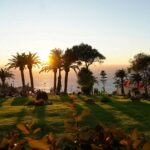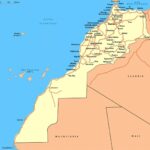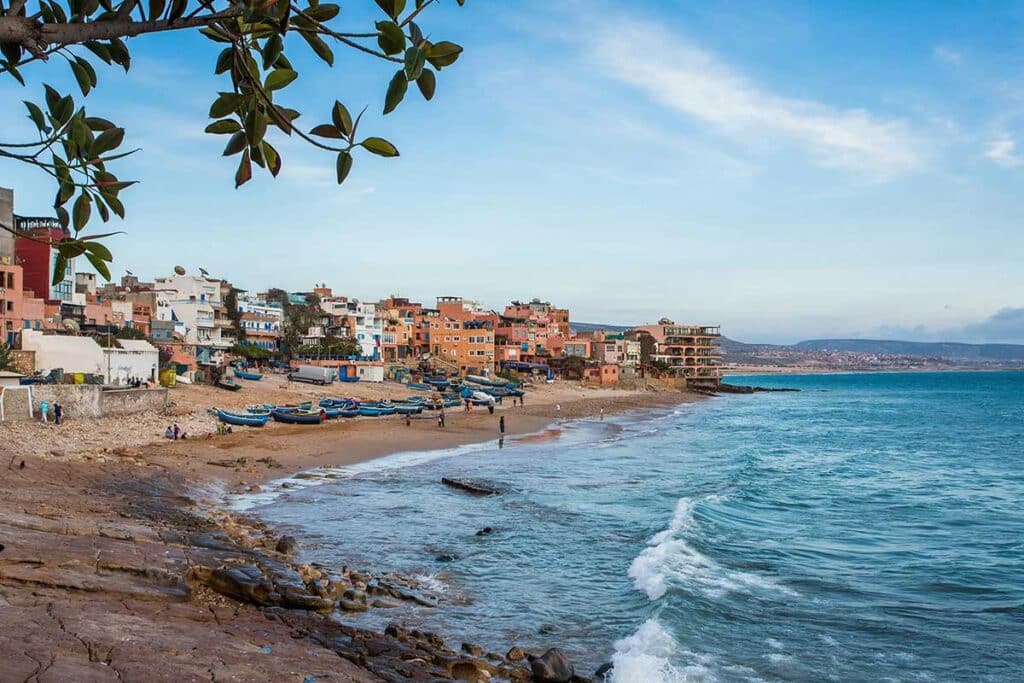
Morocco’s Atlantic Coast
Geographical Overview
Stretching over 1,800 kilometers, Morocco’s Atlantic coast is one of the main regions of Morocco. It is a winding tapestry of sunlit beaches, windswept cliffs, bustling cities, and tranquil fishing villages. Bordered by the vast Atlantic Ocean to the west and the Moroccan plains and mountains to the east, this coastline is where land meets legend. Unlike the more touristy Mediterranean coast, the Atlantic side remains raw, rugged, and full of character. From the cosmopolitan buzz of Casablanca to the artistic soul of Essaouira and the beach paradise of Agadir, the Atlantic coast offers an enchanting blend of experiences.
Whether you’re into history, food, surfing, or just want to soak up the Moroccan sun, this part of the country offers something for everyone. And because it’s less commercialized compared to other tourist destinations, it offers a more authentic Moroccan experience—unfiltered, unspoiled, and unforgettable.
Why the Atlantic Coast is a Hidden Gem
So, why should you choose the Atlantic coast over more well-known spots like Marrakech or the Sahara? Simple—it’s all about diversity and depth. You can start your morning with a traditional mint tea in a centuries-old Medina, spend your afternoon lounging on a pristine beach, and end your evening dancing at a modern beachfront lounge. There’s no other part of Morocco that offers this range in such proximity.
Additionally, the coastal cities are steeped in multicultural heritage. Phoenicians, Romans, Arabs, Portuguese, French—all left their marks on the towns and cities along the Atlantic. This results in a unique cultural fusion that’s visible in everything from the architecture to the food. While Casablanca is a symbol of Morocco’s forward march into modernity, Essaouira holds on to its Bohemian past, and Agadir stands as a beacon of resilience and rebirth.
Add to that the relatively temperate climate all year round, and you have a near-perfect travel destination that’s both relaxing and rich in cultural depth. It’s the kind of place that makes you want to ditch the itinerary and just see where the ocean breeze takes you.
Casablanca: The Beating Heart of Modern Morocco
Casablanca isn’t just Morocco’s largest city—it’s its economic engine, a melting pot of old-world charm and cutting-edge innovation. Walk its streets and you’ll see how effortlessly tradition dances with modernity. One moment you’re passing ancient souks tucked between colonial-era buildings, and the next you’re staring up at sleek skyscrapers and luxury boutiques.
What sets Casablanca apart is its cosmopolitan energy. Unlike the medina-centric cities of Fes and Marrakech, Casablanca is open, expansive, and ever-evolving. It’s a city that looks ahead without forgetting where it came from. French colonial influence is visible in the wide boulevards and Art Deco architecture, yet Islamic tradition anchors its cultural core.
Casablanca is also a city of dreams—quite literally for movie buffs. Who hasn’t heard of the classic film “Casablanca”? While the movie was shot entirely in Hollywood, the spirit of romance, mystery, and rebellion that it evokes still lingers in the city’s ambiance. Casablanca is a city that buzzes with the energy of its people—and it’s a great urban contrast to the more traditional and mountainous charm found in the North of Morocco.
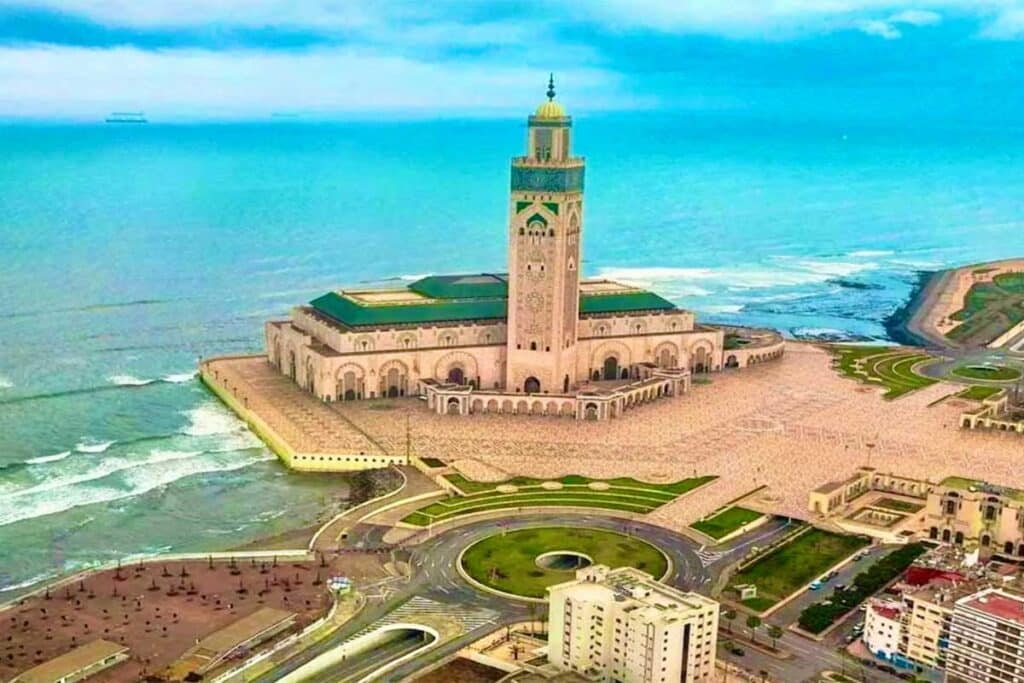
Top Attractions in Casablanca
Hassan II Mosque
Let’s start with the crown jewel—Hassan II Mosque, the largest mosque in Africa and one of the few open to non-Muslims. Perched dramatically over the Atlantic Ocean, this architectural marvel seems to rise straight out of the water. Its 210-meter minaret dominates the skyline, and the intricate zellige tilework, marble floors, and wooden carvings inside will leave you speechless.
Guided tours are available and highly recommended. Even if you’re not religious, the sheer scale and beauty of this mosque are awe-inspiring. The way it seamlessly blends modern engineering with traditional Moroccan craftsmanship is a testament to what the country is capable of.
The Corniche
Next up, head to The Corniche, Casablanca’s lively beachfront promenade. This is where locals and tourists alike come to unwind. Lined with cafes, restaurants, and luxury hotels, it’s the perfect place to enjoy a leisurely stroll or grab a seat with ocean views. Come evening, the area comes alive with music, nightlife, and beach parties.
For a more laid-back vibe, the public beaches here are excellent for sunbathing or taking a dip. The waves are gentle enough for swimming, especially during summer months.
Casablanca’s Art Deco Architecture
Casablanca is an open-air museum for Art Deco enthusiasts. The city’s downtown is dotted with 1930s buildings that echo the golden age of French influence. You’ll find intricate facades, rounded corners, wrought-iron balconies, and mosaic embellishments—many of which are still in use as hotels, banks, and theaters. Don’t miss the Cinema Rialto, a classic movie house that’s still operating and is as much a piece of art as it is entertainment.
Where to Stay and Eat in Casablanca
Casablanca caters to all budgets and styles. For luxury travelers, the Four Seasons Casablanca or Hyatt Regency offer top-tier comfort with stunning sea views. Mid-range travelers can enjoy excellent boutique hotels like Hotel Central or Melliber Appart Hotel, which combine Moroccan charm with modern amenities.
Food-wise, Casablanca is a foodie’s delight. Begin with a taste of cinematic nostalgia at Rick’s Café, modeled after the 1942 classic film and known for its piano evenings and refined Moroccan-international menu. Try La Sqala, a beautiful garden restaurant serving authentic Moroccan dishes in a fortress-like setting. For seafood lovers, Le Cabestan offers upscale oceanfront dining with fresh catches and gourmet twists. And don’t skip the street food—grab a Moroccan sandwich, some grilled sardines, or a fresh orange juice from a local vendor for the real deal.
El Jadida: The Portuguese Coastal Legacy
El Jadida may be small in size, but it carries a massive historical punch. Located about 100 kilometers south of Casablanca, this sleepy coastal city is a perfect stop for those seeking a mix of history, serenity, and Moroccan charm. Once known as Mazagan, El Jadida was a Portuguese stronghold during the 16th century. Walk through its compact medina, and you’ll immediately notice the European influence—stone ramparts, bastions with cannon mounts, and narrow cobbled lanes that feel more like Lisbon than Marrakech.
But El Jadida is far from just a historical relic. It’s a living, breathing city where locals go about their daily lives in a setting steeped in legacy. Whether you’re sipping mint tea along the corniche or exploring the shops in the bustling souk, you’ll feel a calmness here that contrasts sharply with Morocco’s more chaotic cities. El Jadida invites you to slow down, take it all in, and appreciate a side of Morocco that’s beautifully unhurried.
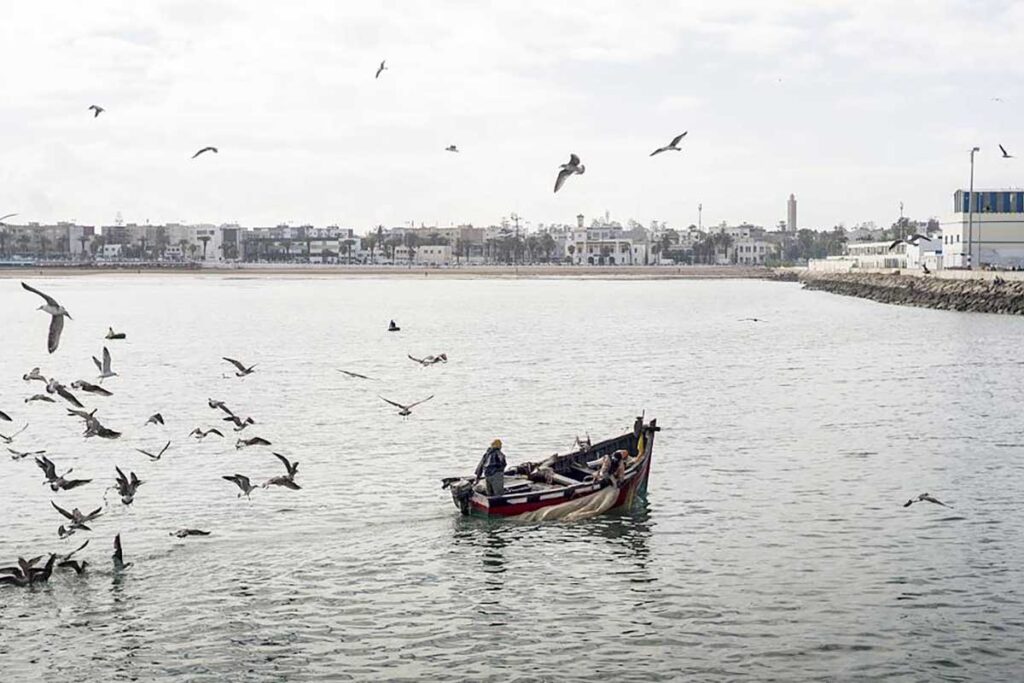
Historical Gems and Seaside Beauty
The crown jewel of El Jadida is the Portuguese Cité, a UNESCO World Heritage Site. This fortified quarter is remarkably preserved, and strolling its stone walls offers panoramic ocean views. The highlight is the Portuguese Cistern, a hauntingly atmospheric underground chamber with reflective water that mirrors its Romanesque arches. The echo inside this space gives it a sacred, almost magical feel.
If history isn’t your thing, the city’s main beach delivers. It’s long, clean, and surprisingly uncrowded. On weekends, families gather for picnics, kids splash in the waves, and street vendors sell roasted nuts, grilled corn, and icy treats. Just a few kilometers away, Sidi Bouzid Beach offers a more upscale beach experience with resorts and excellent surfing conditions.
El Jadida also has a growing reputation for seafood, thanks to its fishing port. Local eateries serve up grilled fish, shrimp tagines, and the region’s signature seafood pastilla—a savory-sweet pastry packed with ocean flavor. It’s not flashy, but it’s deeply satisfying.
Where to Stay and Eat in El Jadida
El Jadida offers a comfortable mix of accommodations, from budget-friendly riads to seaside resorts. Pullman Mazagan Royal Golf & Spa provides luxury right on the coast, perfect for travelers looking to relax in style. For something more traditional, Riad La Villa & Spa in the medina delivers Moroccan hospitality with a boutique feel.
When it comes to food, Chez Kiki is a local favorite known for its authentic Moroccan dishes and fresh seafood. For something quick and delicious, street stalls around the medina serve kefta sandwiches, harira soup, and hot Msemen with honey. Dining here is casual, friendly, and often accompanied by stunning ocean views.
Oualidia: The Serene Lagoon Escape
Tucked between El Jadida and Safi, Oualidia is a peaceful coastal town that seems designed for relaxation. Far from the tourist crowds and urban noise, Oualidia revolves around its crescent-shaped lagoon—protected from the Atlantic’s harsh waves by natural sandbars. The calm, shallow waters make it an ideal destination for swimming, kayaking, and paddleboarding. It’s also one of Morocco’s top picks for family beach holidays thanks to its safety and tranquility.
Oualidia’s natural charm doesn’t end at its lagoon. Surrounding it are salt marshes, cliffs, and wetlands, making the area a birdwatcher’s paradise. During migration seasons, flamingos, herons, and other exotic species flock to the region, painting the skies pink and gold. Add in long, sandy beaches and spectacular sunsets, and you’ve got one of Morocco’s most underrated coastal gems.
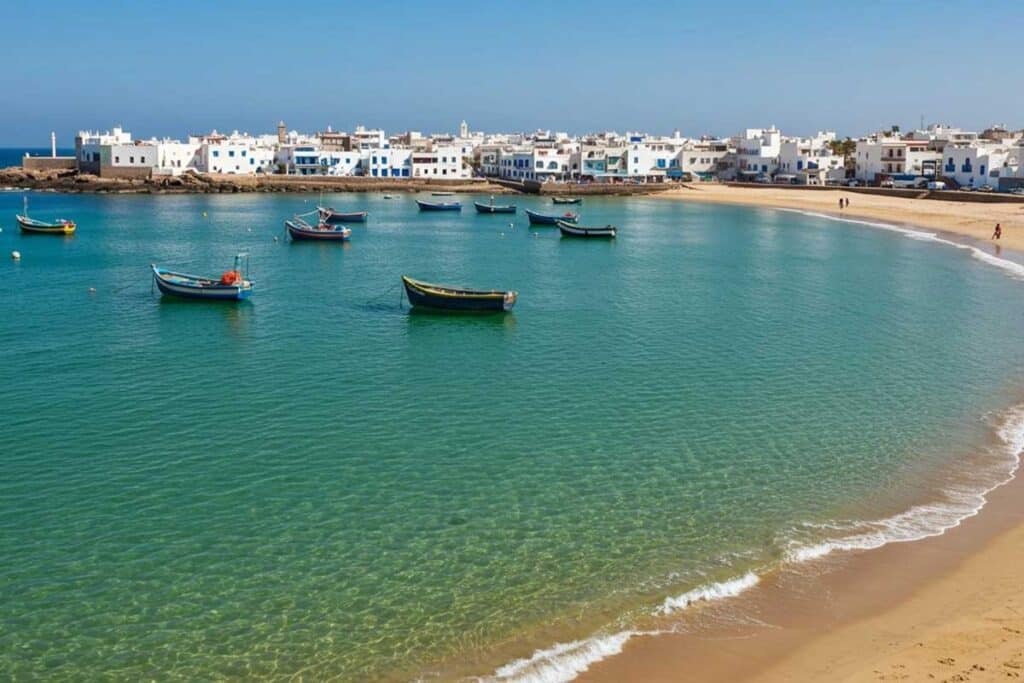
Oysters, Beaches, and Birdsong
One of the most unique aspects of Oualidia is its status as Morocco’s oyster capital. Local oyster farms line the lagoon, and you can enjoy these delicacies fresh from the sea at many small seaside eateries. Try them raw with lemon juice or grilled with garlic and parsley—either way, it’s a local specialty not to be missed.
For beach lovers, Oualidia offers a variety of coastal experiences. The lagoon beach is calm and family-friendly, while the outer Atlantic beach is windier and more rugged—perfect for long walks, horseback riding, or simply enjoying the dramatic ocean waves.
Accommodations in Oualidia are largely boutique and personal. La Sultana Oualidia is the standout—a luxury eco-retreat that blends nature, privacy, and world-class service. But there are also budget-friendly riads and guesthouses that offer cozy stays with homemade breakfasts and lagoon views.
Local Life and Sustainable Tourism
What sets Oualidia apart is its commitment to sustainable, community-driven tourism. Many of the town’s accommodations and restaurants work closely with local producers and artisans. There’s a noticeable lack of chain hotels and mass-tourism here, which helps preserve the town’s authentic charm.
Explore the town’s small market, walk along the quiet streets, or chat with fishermen as they unload the day’s catch. Everything here feels intimate and human. For eco-conscious travelers, Oualidia offers the perfect mix of responsible travel, stunning nature, and local culture.
Safi: Morocco’s Ceramic Capital
Safi is one of Morocco’s most underrated cities—a fascinating port town with deep historical roots, a thriving fishing industry, and an artistic spirit that sets it apart. It sits proudly along the Atlantic, roughly midway between Essaouira and El Jadida, and serves as the country’s undisputed capital of ceramics.
The city’s history is long and layered. Safi was once an important port for the Phoenicians and later the Portuguese, who left behind the imposing Kechla Fortress, perched on a cliff with sweeping views of the ocean. Exploring its stone corridors and battlements gives you a sense of the city’s strategic importance and resilience.
But Safi is not stuck in the past. It’s alive with local color—fishermen hauling in nets, potters shaping clay, and families enjoying seafood meals by the seaside. The medina, while less touristy than others, feels more “real,” with its winding alleys, colorful souks, and street vendors selling everything from spices to handmade tagines.
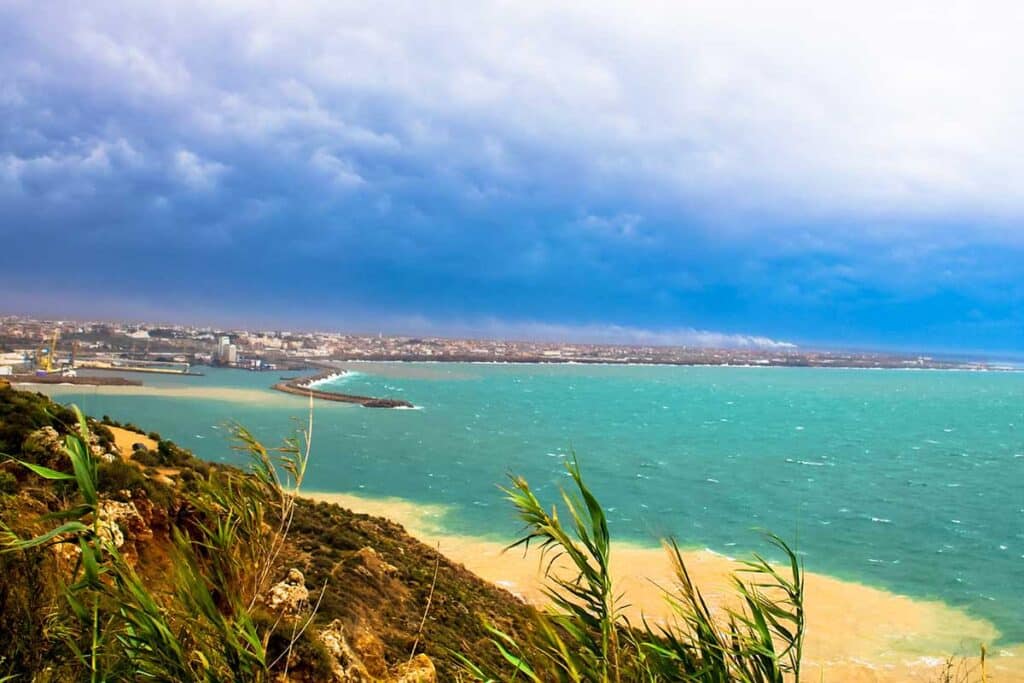
Ceramics, Beaches, and Cultural Riches
Safi is world-famous for its blue-glazed pottery, crafted using techniques passed down through generations. A visit to the Ceramics Quarter (Colline des Potiers) is a must. Here, you can watch artisans mold, paint, and fire their creations in open-air workshops. You can even take a pottery class and create your own souvenir under the guidance of a local master.
Beyond art, Safi offers coastal beauty too. Lalla Fatna Beach, a short drive from the city center, is a favorite for both locals and surfers. The waves can be rough, but the golden sands and towering cliffs create a dramatic and photogenic landscape. It’s a great place to picnic, surf, or just breathe in the salty air.
Safi also has a rich culinary scene that revolves around the ocean. The grilled sardines here are legendary, often served fresh with chermoula and flatbread. Try a bowl of fish tagine or visit one of the seaside eateries for simple, soul-warming dishes made with today’s catch.
Where to Stay and How to Explore Safi
Safi may not have the luxury resorts of Agadir, but it offers a range of comfortable, authentic accommodations. Riad Du Pecheur is a standout, offering spacious rooms with traditional decor and views of the sea. Budget travelers will find plenty of modest hotels and guesthouses with friendly service and easy access to the city’s main attractions.
Safi is also a great base for day trips to nearby towns like Oualidia or Essaouira. It’s well-connected by road and bus, and offers a deeper, more grounded Moroccan experience than its more tourist-heavy neighbors. Whether you’re shopping for ceramics, exploring centuries-old forts, or just enjoying a grilled seafood feast with a view, Safi promises authenticity at every turn.
Essaouira: The Windy City by the Sea
Essaouira might not have the size or glamour of Casablanca, but what it lacks in scale, it makes up for in soul. This coastal town—also known historically as Mogador—is a UNESCO World Heritage Site that has enchanted artists, musicians, and travelers for centuries. With its whitewashed medina, blue shutters, and constant sea breeze, Essaouira is like a painting brought to life.
Its history stretches back to the Phoenicians and Romans, but the city we see today was primarily developed in the 18th century under Sultan Mohammed ben Abdallah. Unlike other Moroccan medinas, Essaouira was built with a clear plan—a grid system influenced by European military architecture, giving it an oddly modern feel for such an old city.
Essaouira has long been a meeting place for different cultures and religions. Jews, Muslims, Christians, Arabs, Berbers, and Europeans have all lived here, contributing to a rich, blended heritage. It’s also the city that attracted rock legends like Jimi Hendrix and Cat Stevens in the 60s and 70s, adding a free-spirited, bohemian vibe that still lingers today.
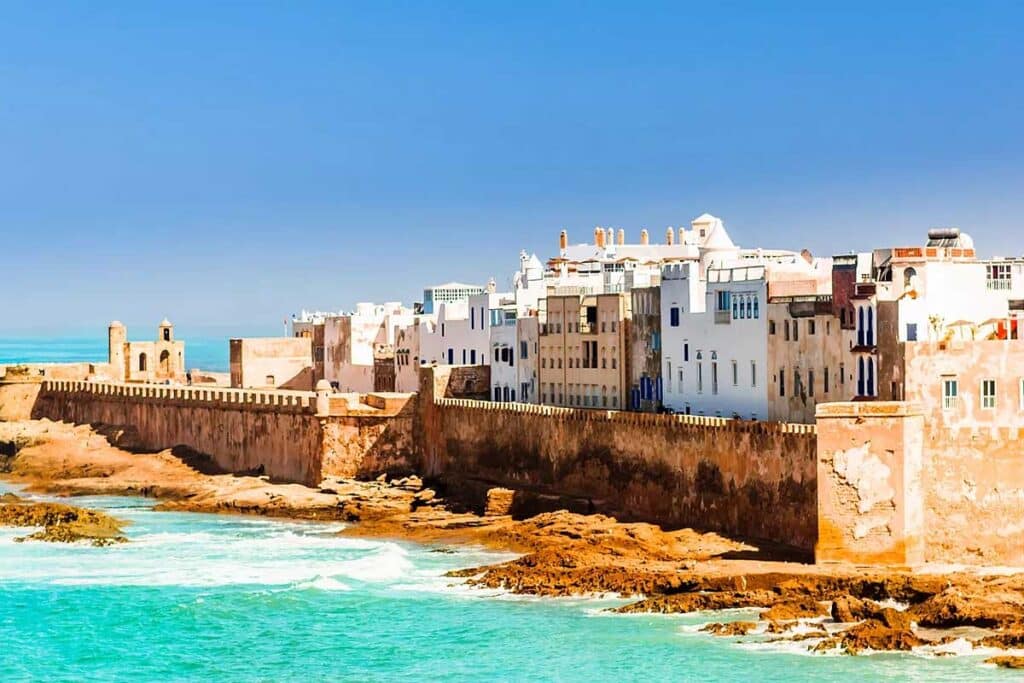
Must-Visit Spots in Essaouira
Skala de la Ville and the Medina
Start your exploration at Skala de la Ville, the city’s fortified sea wall. With rows of old cannons facing the crashing Atlantic waves, it’s one of the most iconic views in Morocco. From here, you can wander through the charming medina, which feels more relaxed than those in Fes or Marrakech. The alleys are lined with art galleries, artisan shops, and cozy cafes, each offering a unique take on Moroccan culture.
Essaouira’s medina is especially known for its woodwork—particularly the use of thuya wood. You’ll find hand-carved boxes, jewelry, furniture, and trinkets that make for unique souvenirs.
Essaouira Beach and Watersports
Unlike many Moroccan beaches that are just for sunbathing, Essaouira Beach is a playground for adventure lovers. Thanks to constant winds, it’s a hotspot for windsurfing and kitesurfing. If you’re new to water sports, there are plenty of rental shops and instructors ready to get you started.
But even if you’re not into the adrenaline rush, a long walk on the golden sands with the Atlantic breeze in your hair is a therapeutic experience. Camel and horse rides are available too, and sunsets here are downright magical.
Local Culture and Cuisine
Essaouira’s food scene is a seafood lover’s dream. Visit the port early in the morning and you’ll see fishermen hauling in fresh catches. You can buy fish directly from them and have it grilled at nearby stalls—a simple but unforgettable experience.
For a more refined meal, try La Table by Madada, known for its elegant fusion of Moroccan and Mediterranean flavors. Street vendors also offer delicious options like sardine meatballs, bissara (fava bean soup), and msemen (pan-fried flatbread) with honey or cheese.
The city is also known for its vibrant music culture, especially Gnawa music, a spiritual blend of African, Berber, and Arabic rhythms. Time your visit with the Gnawa World Music Festival in June, and you’ll witness Essaouira transform into a musical paradise, with free concerts and street performances lighting up the medina.
Agadir: Sun, Sand, and Serenity
Agadir’s story is one of tragedy turned triumph. In 1960, a massive earthquake nearly leveled the city, killing thousands and reducing it to rubble. But from the ashes, Agadir was reborn—modern, spacious, and full of life. Unlike most Moroccan cities that are a mix of ancient and modern, Agadir feels entirely new, with wide boulevards, palm-lined streets, and a distinctly European seaside vibe.
Today, it stands as Morocco’s premier beach resort destination. With over 300 days of sunshine per year and a long, sandy coastline, it attracts sunseekers from around the globe. But beyond the beaches, Agadir also offers a taste of resilience, a chance to see how Morocco balances progress with remembrance.
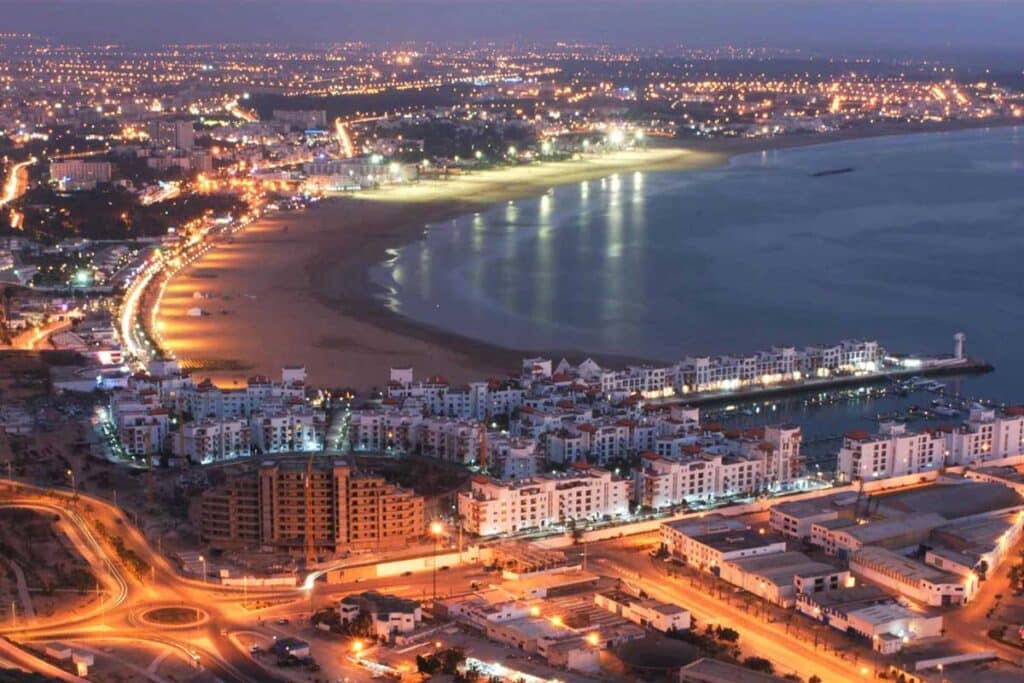
Attractions in Agadir
Agadir Beach
Agadir Beach is the city’s main draw—a vast, golden stretch of sand that’s perfect for sunbathing, swimming, and beach games. Unlike Essaouira’s windy shores, the sea here is calm and great for families. The Promenade, a seaside walkway lined with cafes, shops, and hotels, is ideal for a leisurely evening stroll as the sun dips into the ocean.
Water sports like jet skiing, paddleboarding, and parasailing are available for thrill-seekers. Beachside vendors offer snacks like grilled corn, fresh coconut, and cold juices, making it easy to spend the whole day without leaving the shore.
Souk El Had
For a dose of local flavor, head to Souk El Had, one of the largest markets in Morocco. Covering 13 hectares, it’s a maze of over 6,000 stalls selling everything from spices and textiles to electronics and household goods. This is where locals shop, so prices are better and the atmosphere more authentic than tourist-heavy markets in other cities.
Don’t miss the spice section—piles of saffron, cumin, cinnamon, and ras el hanout fill the air with an intoxicating aroma. Bargaining is expected, so channel your inner negotiator and have fun with it.
Agadir Oufella Ruins
A must-see for history buffs, the Agadir Oufella Ruins sit on a hill overlooking the city. Though much of the original 16th-century kasbah was destroyed in the earthquake, its outer walls remain, and the panoramic view from the top is breathtaking. You’ll get sweeping vistas of the city, port, and beach—all in one frame.
There’s also a new cable car that takes you to the top, making it accessible to everyone. At sunset, the golden light bathes the ruins and the city below in an otherworldly glow—a perfect moment for reflection or a romantic photo.
Agadir’s Modern Vibes and Nightlife
Unlike the medina-rich cities of Morocco, Agadir thrives on its modern offerings. The city boasts luxury resorts, golf courses, wellness spas, and international dining. There’s a palpable sense of leisure here—people come to unwind, recharge, and enjoy life at a slower pace.
Agadir also has a growing nightlife scene. From beach clubs and rooftop bars to traditional Moroccan lounges, there’s something for every kind of night owl. Try So Lounge at the Sofitel or Papagayo Nightclub for a more high-energy vibe. And for a local experience, catch a live Berber performance or join a henna night hosted by some hotels.
The Atlantic Coast Road Trip Experience
Best Route and Transportation Options
One of the best ways to explore the Atlantic coast of Morocco is by road. A classic route starts in Casablanca, winds through El Jadida, Oualidia, Essaouira, and ends in Agadir. This scenic drive offers endless ocean views, picturesque cliffs, and charming villages along the way.
Car rental is widely available and affordable, making it ideal for those who want the flexibility to explore at their own pace. The roads are generally well-maintained, and driving along the coast is straightforward, though some rural stretches may lack signage.
Alternatively, public transportation between major cities is reliable and inexpensive. Intercity buses like CTM and Supratours offer air-conditioned comfort, while local taxis or shared “grand taxis” can take you to smaller towns or attractions.
Get expert tips, destination highlights, and insider advice in our complete Morocco Tour Guide.
Hidden Beaches and Coastal Villages
Beyond the well-trodden tourist paths of Casablanca, Essaouira, and Agadir lie some of Morocco’s best-kept secrets—hidden beaches and coastal villages that offer a more intimate and untouched experience of the Atlantic. These places are perfect for travelers seeking solitude, authenticity, and a deeper connection with nature and culture.
One such gem is Oualidia, often referred to as Morocco’s oyster capital. Nestled between Casablanca and Essaouira, this small town boasts a serene lagoon protected by sandbars, making its waters calm and safe for swimming. The town is dotted with charming beachfront guesthouses and offers some of the freshest seafood you’ll ever taste, including oysters plucked straight from the ocean.
Another lesser-known spot is Taghazout, a laid-back fishing village just north of Agadir that has grown into a surfer’s paradise. The vibe here is bohemian and relaxed, with surf hostels, yoga retreats, and beachfront cafes giving it a backpacker-friendly charm. The beaches are fantastic for both beginners and pro surfers, with famous breaks like Anchor Point attracting wave chasers from around the globe.
Further down the coast, Mirleft and Sidi Ifni offer wild beauty and dramatic coastal cliffs that are a stark contrast to the bustling cities. These sleepy villages are ideal for artists, writers, and anyone needing inspiration or tranquility. Expect dramatic sunsets, quiet beaches, and perhaps a glimpse of dolphins playing in the surf.
These spots may not have five-star resorts or packed itineraries, but that’s the point. Here, you’ll find the Morocco that locals know and love—quiet, authentic, and deeply soulful.

The Culture Along the Coast
Languages, People, and Traditions
The Atlantic coast of Morocco is a melting pot of cultures and identities. You’ll hear Darija (Moroccan Arabic), French, Berber (Amazigh), and even Spanish depending on where you are. Casablanca leans heavily toward French and international languages due to its business environment, while smaller towns and villages retain their Berber roots.
What unites these regions, however, is a deep sense of hospitality. Whether you’re sipping mint tea in a Casablanca café or being offered couscous in a seaside village, you’ll quickly notice that Moroccans are among the most welcoming people on Earth. Their warmth isn’t just a cultural trait—it’s a way of life.
Traditional music, storytelling, and dance remain strong along the coast. In Essaouira, for instance, the hypnotic rhythms of Gnawa music still echo through the streets and courtyards, keeping centuries-old spiritual traditions alive. In Agadir and the southern coast, Berber (Amazigh) culture takes center stage, with festivals and markets celebrating native music, crafts, and oral history.
Coastal Festivals and Events
The coast is also home to some of Morocco’s most exciting cultural events. In addition to the Gnawa World Music Festival in Essaouira, Agadir hosts the Timitar Festival, which celebrates Amazigh music and draws international artists for multi-day performances.
Casablanca isn’t left behind either—it has hosted international jazz festivals, electronic music events, and large-scale art exhibitions that highlight its modern, multicultural identity.
These festivals aren’t just about music; they’re about identity, pride, and community. They provide travelers with a chance to see Morocco in a more intimate and celebratory light, beyond the typical tourist attractions.
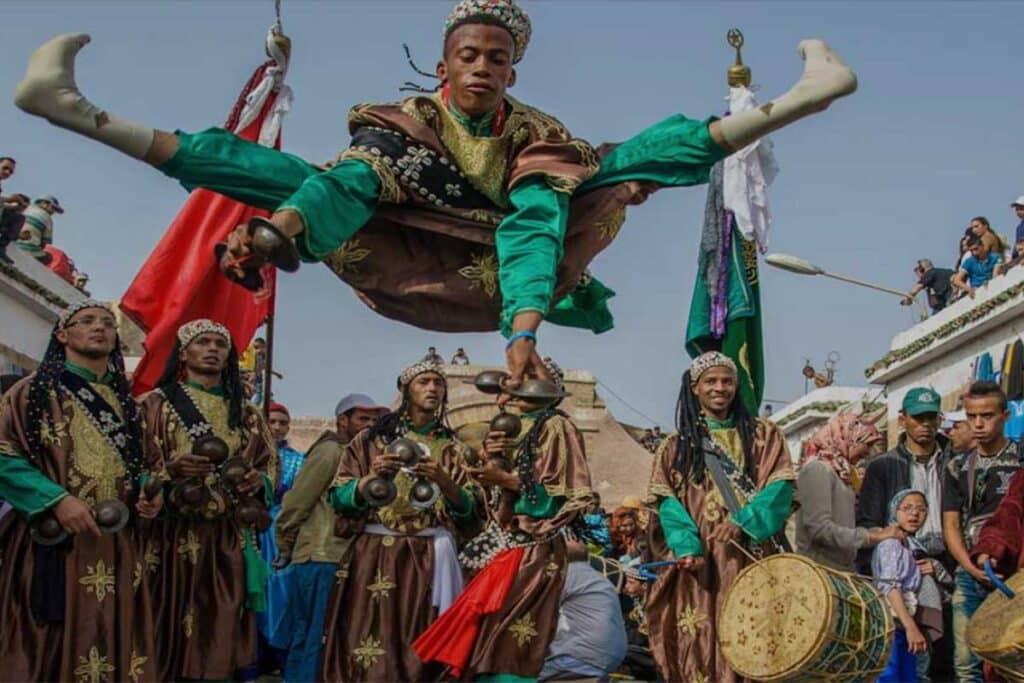
Moroccan Atlantic Coast Cuisine
Street Food Staples
Food along Morocco’s Atlantic coast is an explosion of flavors, smells, and textures that reflects its diverse cultural influences. One of the first things you’ll notice? The food is intensely regional. Street food in Casablanca is entirely different from what you’ll find in Essaouira or Agadir.
In Casablanca, street vendors dish out maakouda (potato fritters), harira (a spicy tomato-based soup), and brochettes (grilled meat skewers). These quick bites are flavorful, affordable, and perfect for travelers on the go.
Essaouira, with its fishing village roots, emphasizes the sea. You can walk to the port and buy fish directly from fishermen, then have it grilled fresh on the spot. Try the sardine meatballs or calamari tagine served with olives and preserved lemons—local favorites that pack a flavorful punch.
Seafood Heaven
The Atlantic Ocean offers a bountiful harvest, and the coastal towns make full use of it. From grilled monkfish and fried sardines to lobster tagines and oyster platters, seafood is king here. Essaouira and Oualidia, in particular, are known for their seafood dishes.
One must-try dish is chermoula-marinated fish, typically grilled and served with a spicy tomato-onion sauce. It’s tangy, smoky, and deeply satisfying. Don’t forget the Moroccan salads—served cold with flavors ranging from citrusy carrots to zesty tomato-onion blends.
Traditional Dishes to Try
No trip along the Atlantic coast is complete without trying classic Moroccan dishes with a coastal twist:
- Tagine with seafood: A bubbling clay pot filled with fish, shrimp, vegetables, and olives.
- Couscous with fish: A Friday favorite in many homes, often served with carrots, zucchini, and chickpeas.
- Rfissa: Typically made with chicken and lentils, but sometimes adapted with fish in coastal towns.
Pair your meals with Moroccan mint tea, often called “Berber whiskey.” Served in ornate glasses with a towering pour, it’s more than a drink—it’s a ritual of hospitality and warmth.
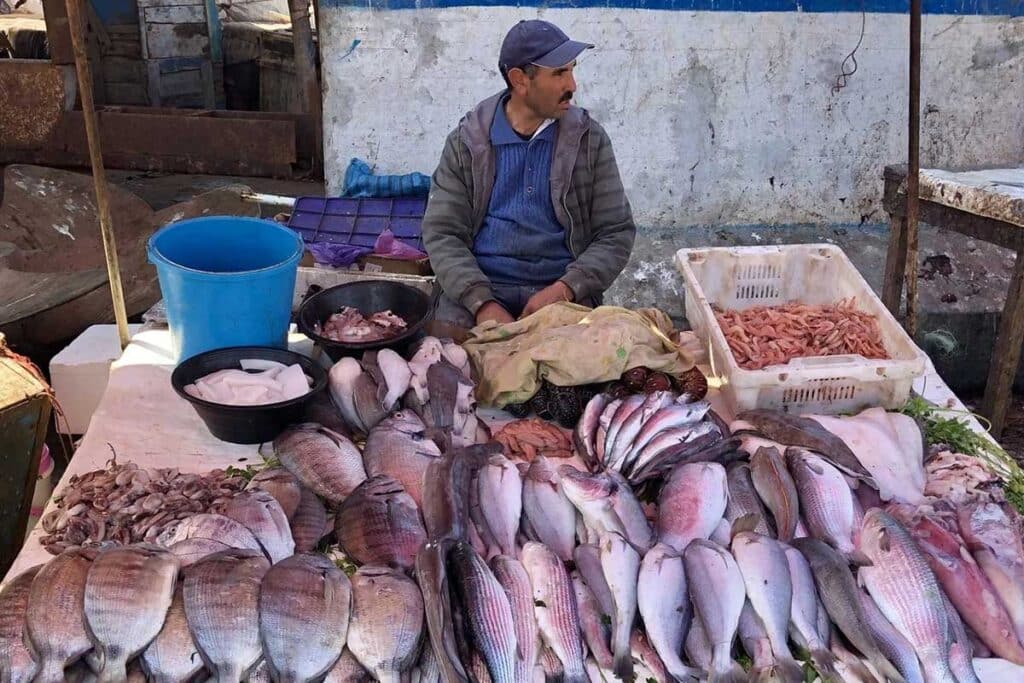
Best Time to Visit the Atlantic Coast
Climate by Season
One of the best things about Morocco’s Atlantic coast is its year-round accessibility. Thanks to the cool Atlantic breeze, the weather here remains relatively mild even during summer. That means you won’t be roasting in 45°C heat like in the Sahara or Marrakech.
- Spring (March to May): Ideal time to visit. Temperatures range from 20°C to 25°C. Everything is in bloom, and it’s not too crowded.
- Summer (June to August): Warm but comfortable, with coastal winds keeping it cool. Essaouira and Agadir are especially popular during this season.
- Autumn (September to November): Another fantastic time for travel. The ocean is still warm, and tourist crowds begin to thin.
- Winter (December to February): Mild and rainy in parts but still enjoyable. Agadir remains sunny and warmer compared to northern cities.
Event Calendars and Off-Peak Advantages
Traveling off-season means better prices, fewer crowds, and a more authentic local experience. Winter, while cooler and occasionally rainy, brings discounts on hotels and flights. If you don’t mind a little drizzle, it’s a peaceful time to explore the coast.
If you’re planning to attend festivals like Gnawa or Timitar, align your trip with June or July. Just make sure to book accommodations well in advance as these events attract thousands of visitors.
Shopping Along the Coast
Souvenirs Unique to Casablanca, Essaouira, and Agadir
Each city along Morocco’s Atlantic coast offers its own flavor of local goods and artisanal treasures. Whether you’re a souvenir hunter or a culture enthusiast, shopping here is more than just a transaction—it’s an experience rich with tradition, creativity, and storytelling.
In Casablanca, head to the Habous Quarter. This district combines the feel of a traditional medina with French urban planning, making it easy to navigate. Here, you’ll find handcrafted leather goods, delicate silver jewelry, brass lanterns, and fine pottery. One must-buy is Moroccan black soap (beldi), used in traditional hammam rituals. Spices, argan oil, and woven textiles are also excellent buys.
Essaouira, with its artistic flair, specializes in thuya woodcraft. Artisans transform the aromatic wood into intricate boxes, bowls, and furniture. You’ll also find colorful paintings, handmade musical instruments like the guembri, and quirky trinkets reflecting the town’s bohemian spirit. The laid-back vibe makes for a relaxed shopping experience, with less pressure to haggle.
In Agadir, modern malls mix with traditional souks. Visit Souk El Had for leather sandals, woven baskets, spices, and Amazigh jewelry. Argan oil cooperatives around Agadir are also worth visiting, where you can buy pure, organic oil directly from local women’s collectives. It’s not just a souvenir—it supports local communities.
Bargaining Tips for the Markets
Haggling is a time-honored tradition in Moroccan markets, but it’s also an art form. Here are some tips:
- Always smile and keep it friendly—it’s a game, not a battle.
- Start by offering half the initial price and work your way up.
- Walk away if needed—chances are, the vendor will call you back with a better deal.
- Compare prices at a few stalls before buying.
- If you’re buying multiple items, bundle them together for a discount.
Remember, bargaining isn’t just about getting the lowest price—it’s about engaging with local culture and showing respect for the merchant’s craft.
Budgeting Your Trip
Cost Breakdown: Luxury vs. Budget Travel
The Atlantic coast of Morocco offers something for every budget. Whether you’re splurging on luxury or counting every dirham, here’s a general idea of what to expect:
Luxury Travelers:
- Hotels: $100–$300+ per night (Four Seasons, Sofitel, boutique riads)
- Meals: $25–$50+ per person at upscale restaurants
- Private guides and transport: $50–$150/day
Mid-Range Travelers:
- Hotels/Riads: $40–$100 per night
- Meals: $10–$25 per person
- Shared tours and taxis: $10–$40/day
Budget Travelers:
- Hostels/Guesthouses: $10–$30 per night
- Street food and cafes: $3–$10 per meal
- Public transport (bus, shared taxi): $1–$10
Money-Saving Hacks for Tourists
- Eat like a local. Street food and family-run cafes serve authentic, affordable meals.
- Use public transport. Buses and grand taxis are safe, cheap, and frequent.
- Book in advance. Flights and accommodations are cheaper when reserved early.
- Stay in riads or Airbnbs. They offer more character and better value than chain hotels.
- Visit free attractions. Beaches, medinas, and local markets don’t cost a dirham.
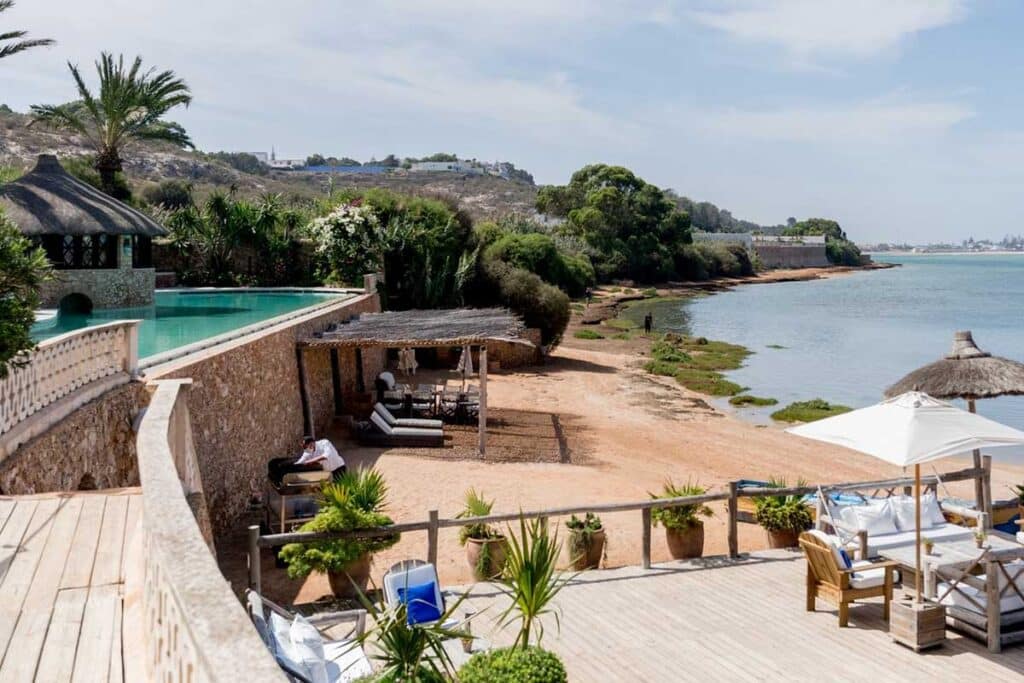
Sustainability and Responsible Tourism
Eco-Friendly Places to Stay
Sustainable travel is becoming increasingly important along Morocco’s coast. Many hotels and riads are embracing eco-practices like solar energy, water conservation, and zero-waste kitchens.
Look for accommodations with eco-certifications or those that partner with local NGOs. In Essaouira, eco-friendly riads often use traditional construction methods and local materials. In Agadir, resorts like Paradis Plage combine luxury with sustainability by offering organic gardens, recycling programs, and green architecture.
Supporting Local Businesses
One of the best ways to travel responsibly is to buy local and eat local. Choose restaurants that source ingredients from nearby farms or co-ops. When shopping, avoid mass-produced items and opt for handmade goods, even if they cost a bit more.
Hire local guides rather than big tour operators. Their insider knowledge will enrich your experience and keep your money circulating within the community. Respect cultural norms, especially in rural villages—dress modestly, ask before taking photos, and learn a few words in Arabic or Berber as a sign of respect.
Tips for First-Time Visitors
What to Pack
Morocco’s Atlantic coast offers a mix of climates and activities, so pack accordingly:
- Clothing: Lightweight, breathable layers for warm days; a light jacket for cooler nights.
- Footwear: Comfortable walking shoes for medinas and sandals for the beach.
- Swimwear: Essential for beach days and hotel pools.
- Sun protection: Sunglasses, sunscreen, and a hat.
- Power adapter: Morocco uses types C and E plugs (220V).
- Personal care: Wet wipes, hand sanitizer, and basic medications.
Common Tourist Mistakes to Avoid
- Overpacking: Stick to essentials; laundry services are available everywhere.
- Skipping smaller towns: Places like Oualidia or Taghazout often become the highlights of a trip.
- Not carrying cash: Many places are cash-only, especially in markets and small towns.
- Ignoring local customs: Public displays of affection, skimpy clothing, and loud behavior may offend locals.
- Not learning basic phrases: A simple “shukran” (thank you) or “salaam” (hello) goes a long way.
Conclusion
Morocco’s Atlantic coast is a treasure trove of contrasts and connections. From the urban heartbeat of Casablanca to the soulful sands of Essaouira and the sunny serenity of Agadir, each stop tells a story—one shaped by history, culture, and the timeless rhythm of the ocean.
This stretch of Morocco isn’t just about visiting places—it’s about feeling them. It’s sipping mint tea as the waves crash below, it’s losing yourself in the maze of a medina, it’s bartering for a handcrafted bowl that will remind you of this journey forever.
Whether you’re a beach bum, a history buff, a foodie, or a free spirit, the Atlantic coast of Morocco has a tide waiting to carry you away. So pack your bags, open your heart, and let this coast change your perspective.
Ready to explore Morocco’s Atlantic coast your way?
From the cultural streets of Casablanca to the peaceful shores of Oualidia, let us craft the perfect journey just for you.
Check out our Morocco Tours and start planning your unforgettable coastal adventure today!
FAQs
The most flexible way is by renting a car, but intercity buses like CTM and Supratours are reliable and affordable for travelers without a car.
Yes, especially along the Atlantic coast. Cities like Casablanca, Essaouira, and Agadir are relatively safe. Just follow standard travel precautions.
Ideally, spend 2 days in Casablanca, 2–3 days in Essaouira, and 3–4 days in Agadir for a well-rounded experience.
Absolutely! Taghazout, near Agadir, is world-famous for surfing. Essaouira is also popular for windsurfing and kitesurfing.
It depends on your nationality. Many travelers from the EU, US, and Canada can enter visa-free for up to 90 days. Always check with your local embassy.



